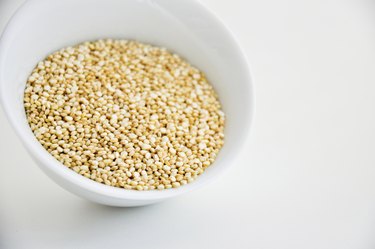
Amaranth vs, quinoa share many similarities, beginning with a common history. These ancient crops are native to South America and serve as staples in many parts of the world.
While amaranth and quinoa are relatively new to the American market, they're gaining in popularity because they contain quality protein, they're gluten-free and both are rich sources of minerals. Another similarity between the two is this: Technically, they're not cereal grains.
Video of the Day
Video of the Day
Read more: Quinoa and Weight Loss
Compare Amaranth Vs. Quinoa
Even though amaranth and quinoa are called whole-grain foods, they're not true cereal grains. Both of them are edible seeds called pseudocereals because they share many of the same characteristics as whole-grain cereals. These seeds are prepared and consumed the same way as rice and oats. You may also find them in other forms such as flaked or ground into flour.
Both have similar macronutrients. One cup of cooked amaranth has 251 calories and 46 grams of total carbohydrates, compared to quinoa with 222 calories and 40 grams of carbs, according to the USDA. They each have 5 grams of dietary fiber, which is 21 percent of women's and 14 percent of men's recommended daily intake.
More Protein Than Grains
Amaranth contains slightly more protein than quinoa, but they both provide double the amount you'll get from brown rice, oats and whole wheat. Amaranth has 9 grams of protein in a 1-cup serving, while quinoa has 8 grams, according to the USDA. According to Harvard Health Publishing, the Recommended Daily Allowance (RDA) for protein is 0.8 grams per kilogram of body weight.
Besides the quantity of protein, the second advantage you'll get from amaranth and quinoa is the quality of protein. Most whole grains are low in the amino acid lysine. Amaranth and quinoa contain enough lysine that they both provide complete protein.
A Boost of Minerals
No matter which you choose, both grains are rich sources of magnesium and zinc. They also supply a boost of iron, but amaranth has two times more than quinoa, according to the USDA. Iron is well-known for its role transporting and storing oxygen, and it also helps synthesize DNA and is a component in antioxidants that protect white blood cells working for your immune system.
Women need 18 milligrams of iron daily to replace the amount lost during menstruation. After menopause, women have the same recommended dietary allowance, or RDA, as adult men of all ages: 8 milligrams daily, according to Linus Pauling Institute. One cup of cooked amaranth contains 5 milligrams of iron. You'll get 3 milligrams of iron from the same portion of quinoa.
Read more: Brown Rice Vs. Quinoa
Recognize the Differences
As a group, the B vitamins keep your metabolism going by supporting enzymes that convert food into energy. Vitamin B-6 helps produce serotonin, which stabilizes moods and has a role regulating sleep cycles, according to Harvard Health Publishing.
Both seeds are good sources of vitamin B-6., according to the USDA. One cup of amaranth contains 22 percent of your RDA of vitamin B-6, compared to 18 percent from quinoa. However, quinoa provides about 15 percent of your RDA of thiamine and riboflavin, which is four times more than you'll get from amaranth.